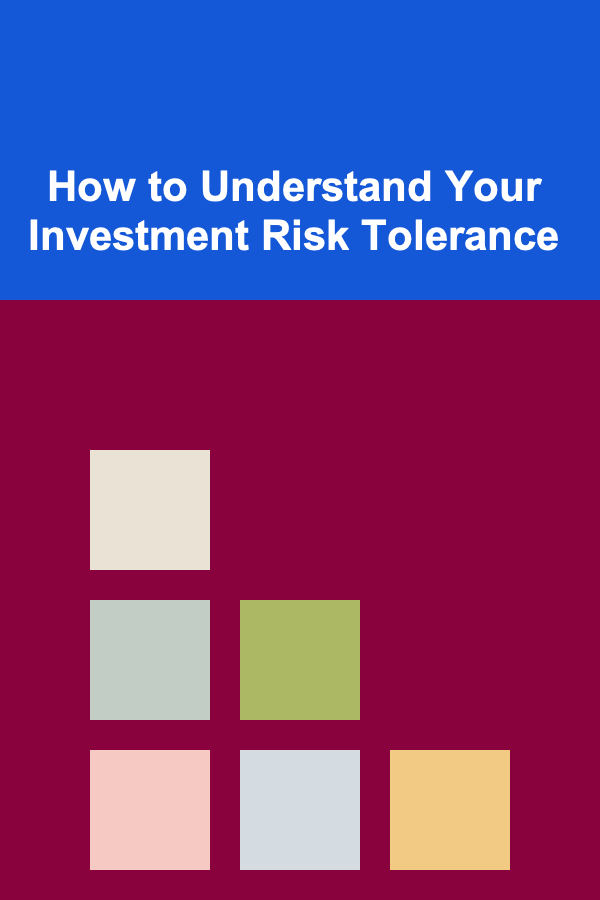
How to Understand Your Investment Risk Tolerance
ebook include PDF & Audio bundle (Micro Guide)
$12.99$5.99
Limited Time Offer! Order within the next:

Investing is an essential part of building wealth, but it comes with its risks. One of the most crucial factors in successful investing is understanding your investment risk tolerance. Your risk tolerance refers to the amount of volatility or risk you are willing to take in your investments to achieve your financial goals. The higher the risk, the higher the potential reward, but it also increases the potential for loss. Understanding your risk tolerance will help you make more informed investment decisions, align your portfolio with your financial objectives, and ultimately achieve financial security.
In this article, we'll explore what risk tolerance is, the factors that influence it, how to assess your own risk tolerance, and how to use that understanding to make better investment decisions.
What Is Investment Risk Tolerance?
Investment risk tolerance is the degree of uncertainty or potential financial loss you are willing to accept in pursuit of financial gain. It is a personal and dynamic characteristic that varies from individual to individual. Some investors may be comfortable with high-risk, high-reward investments, while others prefer more conservative options with lower risk.
Risk tolerance is often divided into several categories, typically ranging from conservative to aggressive:
- Conservative: A low tolerance for risk, preferring investments that are safer but may offer lower returns.
- Moderate: A balanced approach, accepting some risk in order to achieve moderate returns.
- Aggressive: A high tolerance for risk, pursuing higher returns with the acceptance of the possibility of significant loss.
Understanding where you fall on this spectrum is key to crafting an investment strategy that aligns with your financial goals and personal comfort level.
Why Is Risk Tolerance Important?
Risk tolerance is essential for several reasons:
- Helps with Investment Strategy: Understanding your risk tolerance helps you choose the right mix of investments for your portfolio. A portfolio that aligns with your tolerance will give you the confidence to stick with your strategy during market fluctuations.
- Aids in Emotional Control: Investors who choose investments that align with their risk tolerance are less likely to panic during market downturns. Being overly aggressive when you are risk-averse can lead to stress and poor decision-making.
- Long-Term Goal Achievement: A well-calculated risk tolerance will ensure that your investment strategy supports your long-term goals, whether it's saving for retirement, a home, or education, while avoiding the possibility of making rash investment decisions based on fear or greed.
- Maintains Portfolio Balance: Risk tolerance helps you create a balanced portfolio by diversifying your assets, thus avoiding putting all your eggs in one basket. A good balance of risky and safe assets can help you manage volatility.
Factors Influencing Your Risk Tolerance
Several factors influence your investment risk tolerance. These include:
1. Time Horizon
Your time horizon refers to the length of time you expect to hold your investments before needing to access the funds. The longer your time horizon, the more risk you can typically afford to take, as you have more time to recover from market downturns.
- Short-Term Goals (1-5 years): If you need to access the money in the near future, such as for a down payment on a house or an emergency fund, you might prefer lower-risk investments like bonds or savings accounts.
- Long-Term Goals (10+ years): If you're saving for retirement or long-term wealth, you can afford to take more risks with your investments, as you have the time to ride out market fluctuations.
2. Financial Situation
Your current financial situation plays a big role in your risk tolerance. If you have significant debt or other financial obligations, you may have a lower tolerance for risk. However, if you have a strong financial foundation, an emergency fund, and disposable income, you may feel more comfortable taking on higher risk.
- Stable Income & Savings: Investors with a stable financial situation may be more comfortable with riskier investments since they have a cushion to fall back on.
- Debt or Financial Strain: Those struggling with debt or uncertain financial situations may prefer lower-risk investments to avoid potential losses that could exacerbate their financial stress.
3. Personality and Emotions
Your personality and emotional responses to market changes are also critical factors. Some people are naturally more risk-averse and uncomfortable with volatility, while others may find the potential for higher returns exciting and motivating.
- Risk-Aversion: If you tend to avoid risky situations or get anxious when markets drop, you might be more comfortable with safer, conservative investments.
- Risk-Seeking: If you are willing to tolerate swings in your portfolio value in hopes of higher returns, you may be more inclined to take on riskier investments, such as stocks, high-yield bonds, or emerging market assets.
4. Investment Knowledge and Experience
Your knowledge and experience with investments play a significant role in your comfort with taking on risk. Seasoned investors may be more comfortable with risk because they understand the markets better, while novice investors may lean toward safer investments due to a lack of experience.
- Knowledgeable Investors: Investors with more knowledge of financial markets, investment vehicles, and market history may be more comfortable with risk.
- Beginner Investors: Those who are newer to investing may prefer lower-risk investments while they build knowledge and experience.
5. Financial Goals
Your specific financial goals will also influence your risk tolerance. If you're aiming for quick wealth accumulation or higher returns, you may accept higher risk. If you simply want to preserve wealth, such as saving for retirement, you might prioritize stability over growth.
- Aggressive Growth: If your goal is to grow wealth quickly, you may take on higher risks with stocks, real estate, or other volatile assets.
- Wealth Preservation: If your goal is to preserve your capital and achieve steady returns, you may lean toward conservative investments like bonds or dividend-paying stocks.
How to Assess Your Investment Risk Tolerance
There are several ways to assess your risk tolerance. The most common approach is through self-assessment tools, questionnaires, and discussions with a financial advisor.
1. Risk Tolerance Questionnaires
Many investment firms and financial advisors offer risk tolerance questionnaires. These questionnaires ask questions about your financial goals, time horizon, income, and emotional responses to market fluctuations. Based on your answers, the questionnaire will suggest a risk tolerance level: conservative, moderate, or aggressive.
2. Simulate Market Volatility
Another way to assess your risk tolerance is by simulating how you would feel if your portfolio experiences significant losses. Imagine how you would react if your investments lost 10%, 20%, or 50% in value. Would you panic and sell, or would you be comfortable riding it out?
3. Consult with a Financial Advisor
If you're unsure about your risk tolerance, consider consulting with a financial advisor. A professional can help you understand your financial goals, evaluate your risk tolerance, and recommend appropriate investments based on your unique circumstances.
How to Use Risk Tolerance in Your Investment Strategy
Once you've assessed your risk tolerance, you can tailor your investment strategy accordingly. Here are some strategies based on different levels of risk tolerance:
1. Conservative Strategy
If you have a low risk tolerance, you'll want to focus on preserving your capital and achieving steady, modest returns. A conservative portfolio typically includes:
- Bonds: Government bonds, municipal bonds, or high-quality corporate bonds are ideal for conservative investors.
- Dividend Stocks: Stocks from stable companies that pay regular dividends can provide income with lower volatility.
- Money Market Funds: Low-risk, liquid investments that are typically used for short-term savings.
2. Moderate Strategy
A moderate strategy balances risk and reward, aiming for long-term growth while protecting against excessive losses. This portfolio might include a mix of:
- Balanced Mutual Funds or ETFs: Funds that invest in both stocks and bonds.
- Index Funds: Low-cost funds that track a broad market index, providing exposure to a diversified range of stocks.
- Real Estate: Investments in real estate can provide steady returns with moderate risk.
3. Aggressive Strategy
If you have a high risk tolerance and are seeking higher returns, your portfolio may include more volatile assets, such as:
- Stocks: Equities in growth companies or emerging markets that have higher potential returns but greater volatility.
- Cryptocurrency: A relatively new and highly volatile asset class that could provide high returns but comes with significant risk.
- Venture Capital or Startups: Investing in early-stage companies can yield high rewards but carries a higher chance of failure.
Conclusion
Understanding your investment risk tolerance is a fundamental aspect of creating an investment strategy that suits your financial goals and personal comfort level. By assessing your time horizon, financial situation, emotional responses, and investment knowledge, you can determine how much risk you are willing to take in pursuit of your goals. Remember that risk tolerance is not static; it can change over time based on changes in your financial situation, life events, or market conditions. Regularly reassessing your risk tolerance ensures that your investment strategy remains aligned with your long-term objectives.
By understanding and respecting your risk tolerance, you can confidently navigate the world of investing and build a portfolio that supports your financial future while minimizing unnecessary stress and fear.

How to Create a Checklist for Screening Resumes and Applications
Read More
How to Create a Safe Room in Your Home for Maximum Security
Read More
How to Create a Seasonal Utensil Rotation System
Read More
How to Find the Best Storage Solutions for Small Garages
Read More
How to Find Exciting Wildlife Encounters
Read More
How to Explore the World of the Sumerians
Read MoreOther Products

How to Create a Checklist for Screening Resumes and Applications
Read More
How to Create a Safe Room in Your Home for Maximum Security
Read More
How to Create a Seasonal Utensil Rotation System
Read More
How to Find the Best Storage Solutions for Small Garages
Read More
How to Find Exciting Wildlife Encounters
Read More